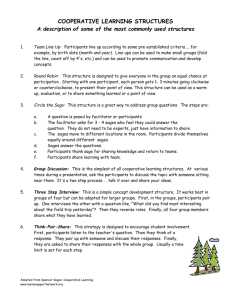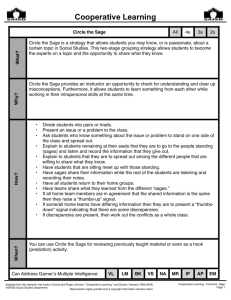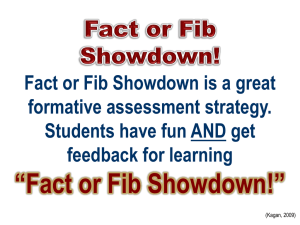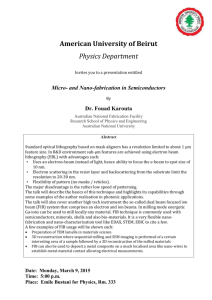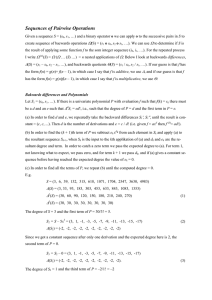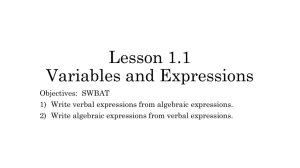Cooperative Learning Structures
advertisement
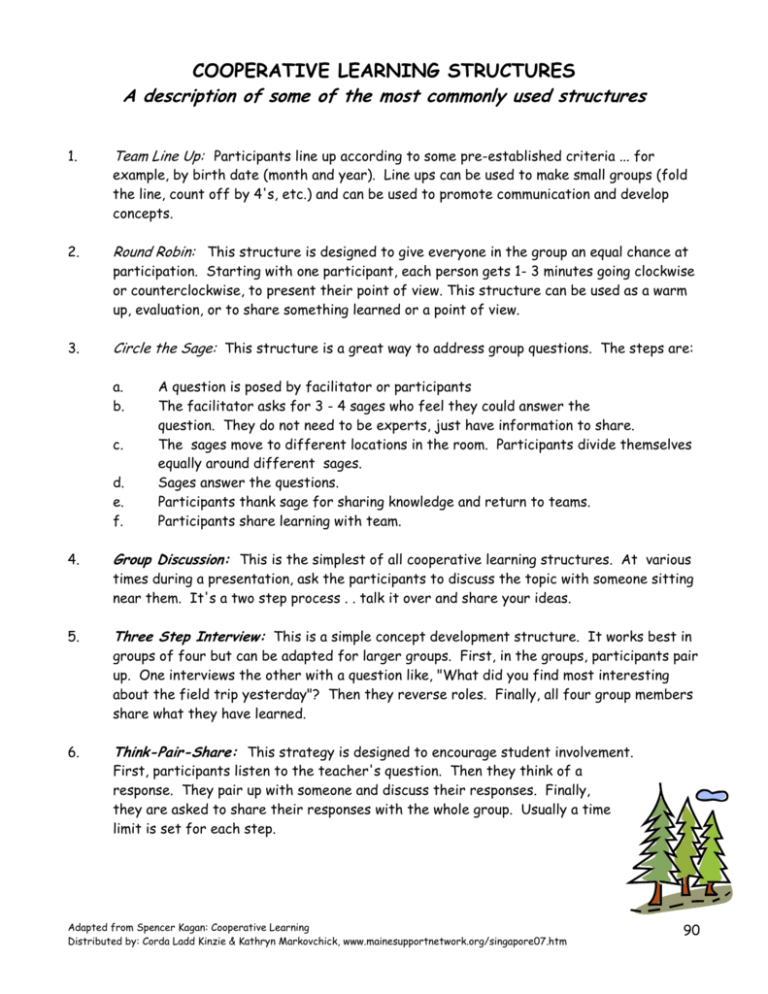
COOPERATIVE LEARNING STRUCTURES A description of some of the most commonly used structures 1. Team Line Up: Participants line up according to some pre-established criteria ... for example, by birth date (month and year). Line ups can be used to make small groups (fold the line, count off by 4's, etc.) and can be used to promote communication and develop concepts. 2. Round Robin: This structure is designed to give everyone in the group an equal chance at participation. Starting with one participant, each person gets 1- 3 minutes going clockwise or counterclockwise, to present their point of view. This structure can be used as a warm up, evaluation, or to share something learned or a point of view. 3. Circle the Sage: This structure is a great way to address group questions. The steps are: a. b. c. d. e. f. 4. A question is posed by facilitator or participants The facilitator asks for 3 - 4 sages who feel they could answer the question. They do not need to be experts, just have information to share. The sages move to different locations in the room. Participants divide themselves equally around different sages. Sages answer the questions. Participants thank sage for sharing knowledge and return to teams. Participants share learning with team. Group Discussion: This is the simplest of all cooperative learning structures. At various times during a presentation, ask the participants to discuss the topic with someone sitting near them. It's a two step process . . talk it over and share your ideas. 5. Three Step Interview: This is a simple concept development structure. It works best in groups of four but can be adapted for larger groups. First, in the groups, participants pair up. One interviews the other with a question like, "What did you find most interesting about the field trip yesterday"? Then they reverse roles. Finally, all four group members share what they have learned. 6. Think-Pair-Share: This strategy is designed to encourage student involvement. First, participants listen to the teacher's question. Then they think of a response. They pair up with someone and discuss their responses. Finally, they are asked to share their responses with the whole group. Usually a time limit is set for each step. Adapted from Spencer Kagan: Cooperative Learning Distributed by: Corda Ladd Kinzie & Kathryn Markovchick, www.mainesupportnetwork.org/singapore07.htm 90 7. Jigsaw: This structure can be used in a variety of ways for mastery, concept development, discussion and whole group projects. The simplest form, Within Team Jigsaw, has three basic steps. a. Each participant from a team works alone, mastering a bit of information. b. Participants do a round robin within teams to share their knowledge with teammates. c. There is an assessment of all students on all material. 8. Corners: This structure is designed to allow participants to get to know themselves and each other better. It can be used as a content-related classbuilder or used after a lesson as a review. The steps are: a. The facilitator announces the corners . . . which state they would like to visit . . . whatever. b. Participants think about their choices. c. They write down their choices on a piece of paper. d. They go to the corner of their choice. e. They talk with others in the corner about why they chose it. f. A spokesperson from the corner shares with the whole group why they chose it. g. After hearing all of the reasons, participants can then change corners. h. Participants return to their tables and review their reasons. 9. Guess-the-Fib: This can be played either within teams or within the class. When played within teams, participants try to fool their teammates; when played within the class, teams try to fool other teams. The idea is simple. In Guess-the Fib students state two rather unbelievable facts and one believable fib. They announce all three as facts, and it is the job of the teammates, or other teams to guess which one is the fib. Finger responses can be used with Guess-the Fib. Students simply hold up one, two, or three fingers, depending on which statement they believe is the fib. 10. Inside-Outside Circle: Participants stand in two concentric circles, with the inside circle facing out and the outside circle facing in. They make a quarter right turn. The facilitator tells them how many to rotate, they face a partner and share information, such as name, where born, favorite book. Inside-Outside Circle is an excellent activity for sharing information in pairs. It is a nice closing activity to share one highlight and one thing they will do as a result of the workshop. 11. Spend-A-Buck: When students must reach a decision quickly, Spend-A-Buck can be used. Each student is given four quarters to spend any way they wish on the choice alternatives. Each student must spend his/her quarters on more than one item. The team then tallies the results to determine the team decision. Spend-A-Buck, unlike voting, does not produce clear winners and losers. To make the decision even less polarized, have the teams spend ten dimes. With this version each member is obliged to spend something on at least three items. Adapted from Spencer Kagan: Cooperative Learning Distributed by: Corda Ladd Kinzie & Kathryn Markovchick, www.mainesupportnetwork.org/singapore07.htm 91
